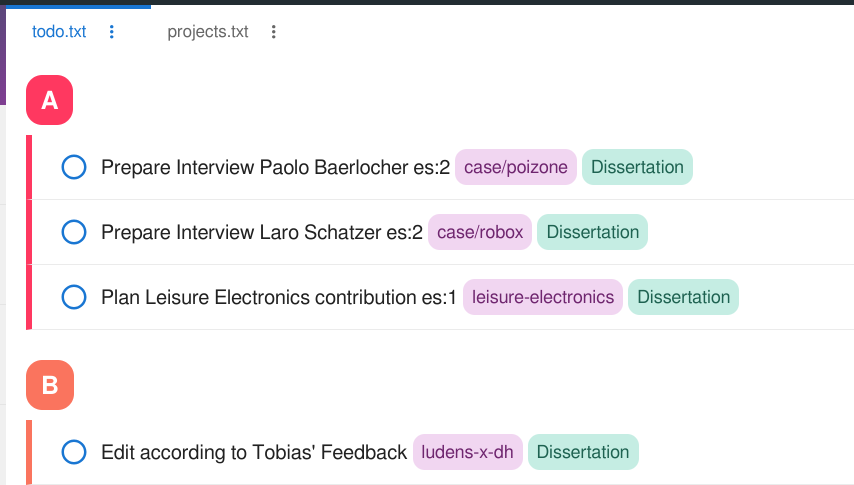The Definitive Guide to ADHD Project Management
The title is kind of a joke, but everybody who knows me is very well aware of me being obsessed with organization. Honestly, I don’t have much of a healthy relationship with my to-dos. So here are some thoughts on how I go about this, beyond tools (maybe a little tools at the end).
Basically, once a week and mostly on Sundays, I want to know when I need to do what to achieve my goals. To get there, I break down the steps needed into tasks. A task can be its own goal, but it can also be part of an overarching project. Sometimes these projects are clearly delineated, with deadlines and a form that it should have at the end. Other times, these projects are more of a process, and the tasks help drive it forward. The last two elements of importance are time and priorities. The latter may be increased by external pressure, such as deadlines, or by my own desire to get things done. The whole thing is framed by the time available, which depends on how many fixed events are already in the calendar and how much time the individual task will need.
Somewhere, besides this entanglement, is the backlog of things that might have to be done or abandoned at one point.
So there are a number of interdependencies, and every now, and then I have to pit things against each other because the time available doesn’t allow for all priorities to be taken care of, or because I’m running out of energy. That’s usually when I agreed to too many additional involvements. That said, it’s important to mention that tasks are just steps to help achieve a goal. Nobody will get sick and die for not having tasks done (sometimes the contrary is the case). That’s mostly something I have to tell myself to not get overly stressed.
graph LR;
subgraph X [No Priority]
I[Ideas and Wishes]
PF[Other Projects]
TF[Other Tasks]
end
subgraph Z [Available Time]
G[Goals]
P[Projects]
T[Tasks]
Pr[Priorities]
ZT[Time]
P --> G
T --> P
T --> G
Pr -.-> T
Pr -.-> P
ZT --> T
end
Don’t let yourself be fooled by the diagram. It is meaningless…
Process
I usually go about this on Sunday evenings. Most of the fixed events for the next week are on the calendar and I can roughly guess, how much time I have left to get things done. I highly dislike being exact with my planning. It never turned out well. So I usually just block 1–3 hours for a project, within which I do the tasks belonging to that one. Loose tasks, such as administrative things or returning emails, get bundled into their own time slots.
- Figure out available time slots by looking at my calendar
- Figure out which projects and tasks have a high-priority
- Figure out how much time tasks will take or how much I want to invest in them
- Put roughly guessed tasks’ project into time slots
- Voilà ✨
Pivoting into tools
There are some people who swear on putting those time slots into your calendar, but I’m more comfortable at keeping the calendar for appointments. Instead, I make a little cute table in my journal’s weekly note:
| 📅 | 🐓 | 🌞 | 🌛 |
|---|---|---|---|
| Mon | comm, +metadata | +metadata | Roxy |
| Tue | +technicity | +metadata | |
| Wed | comm, +mcp-lecture | +sdn24, office | Willy |
| Thu | +ludes-x-dh | +ludens-x-dh | family |
| Fri | +ludens-x-dh, meetings | family | |
| Sat | a longer walk | shop and cook | |
| Sun | household | ||
| The ones with an + are ongoing projects, since I use todo.txt. That looks like this in plain text: |
(A) Prepare Interview Paolo Baerlocher es:2 +case/poizone @Dissertation
(A) Plan Leisure Electronics contribution es:1 +leisure-electronics @Dissertation
(B) Invite SDN24 panelists +sdn24 @Work
(D) Read Critical Code Studies +technicity @Dissertation @Reading
and like this in Sleek:

Because of this specific process, I only add due dates when something has a very concrete deadline, and not because I want to do it on that day. The es:2 is an unofficial property where I guess how much time something would need. Once a specific time slot with its allocated project arrives during the week, I open Sleek, filter by project and take a look at my tasks that I’d like to do.
So what?
The gist of this text is, that there are different entry-points into deciding what needs to be done, some of which outlined above. But, next to the priorities and available time, there is also my energy-level and how much I can concentrate to be considered. I don’t fare well with a meticulously planned agenda. Those tend to rather burn me up. There needs to be a balance in knowing what there is to do and being able to adapt that plan to the circumstances. My tasks then become rather a bag of reminders, what I wanted or planned to do, which I revisit regularly and take out what I’m able to handle at the moment.